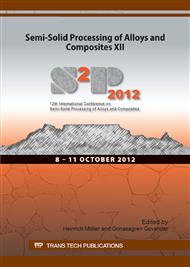p.488
p.494
p.500
p.506
p.515
p.521
p.527
p.533
p.539
Production of Titanium Alloy Components by Semi-Solid Forming
Abstract:
The relatively high costs of processing titanium alloys and the high variability in the products' quality currently represent the major economic obstacles to using such materials in either production or medical engineering. For this reason, new research and development work at the Institute for Metal Forming Technology of the University of Stuttgart is pursuing the objective of improving and enhancing pre-existing processes for these types of materials. In doing this, aspects are considered which specify definite mechanical properties during and after the forming process as well as reduce the costs by means of cutting the manufacturing times, increase the use of semi-finished products and minimise finishing operations.
Info:
Periodical:
Pages:
515-520
Citation:
Online since:
October 2012
Authors:
Keywords:
Price:
Сopyright:
© 2013 Trans Tech Publications Ltd. All Rights Reserved
Share:
Citation:


